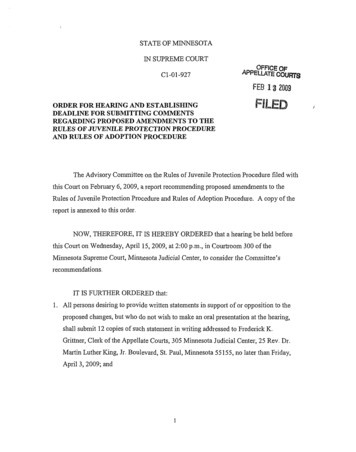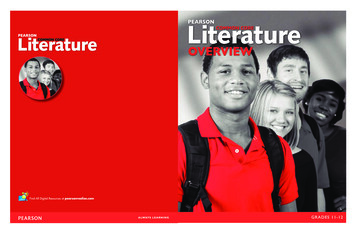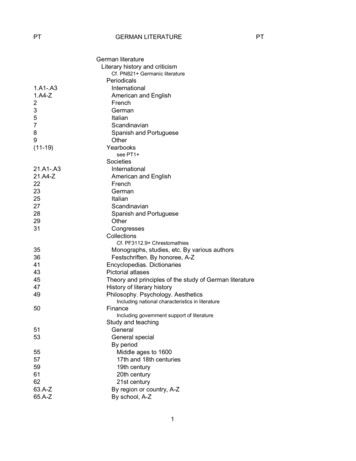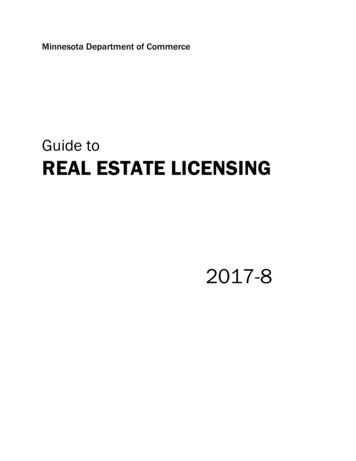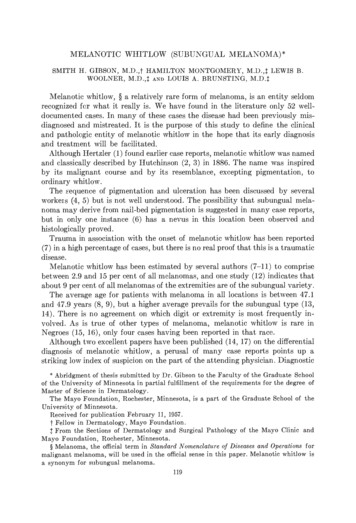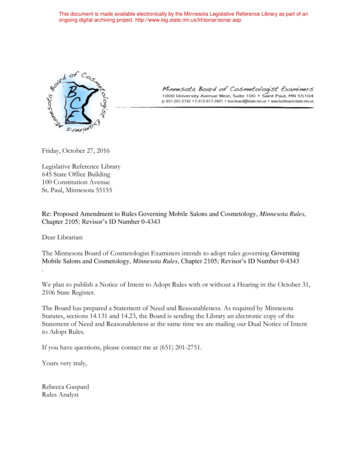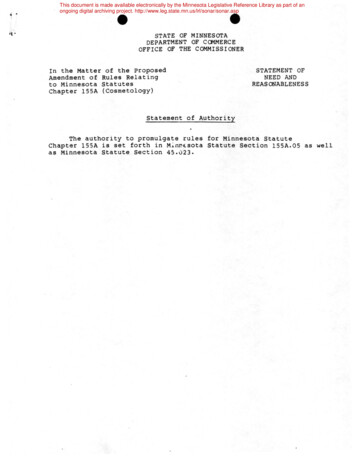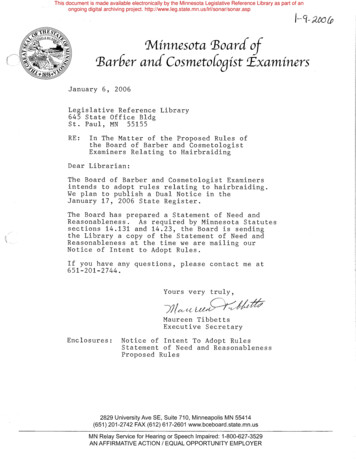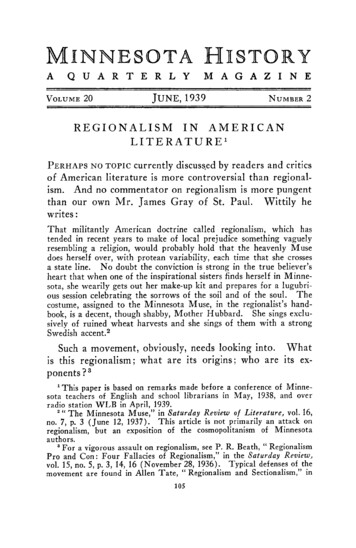
Transcription
MINNESOTAHISTORYAM A G A Z I N EQ U A R T E R L YVOLUME20JUNE, 1939NUMBER 2REGIONALISM IN A M E R I C A NLITERATURE PERHAPS NO TOPIC currently dlscuss,ed by readers and criticsof American literature is more controversial than regionalIsm. And no commentator on regionalism is more pungentthan our own Mr. James Gray of St. Paul. Wittily hewrites:That militantly American doctrine called regionalism, which hastended in recent years to make of local prejudice something vaguelyresembling a religion, would probably hold that the heavenly Musedoes herself over, with protean variability, each time that she crossesa state line. No doubt the conviction is strong in the true believer'sheart that when one of the inspirational sisters finds herself in Minnesota, she wearily gets out her make-up kit and prepares for a lugubrious session celebrating the sorrows of the soil and of the soul. T h ecostume, assigned to the Minnesota Muse, in the regionalist's handbook, is a decent, though shabby. Mother Hubbard. She sings exclusively of ruined wheat harvests and she sings of them with a strongSwedish accent. Such a movement, obviously, needs looking Into. Whatis this regionalism; what are its origins; who are Its exponents?** This paper is based on remarks made before a conference of Minnesota teachers of English and school librarians in May, 1938, and overradio station WLB in April, 1939." " The Minnesota Muse," in Saturday Review of Literature, vol. 16,no. 7, p. 3 (June 12, 1937). This article is not primarily an attack onregionalism, but an exposition of the cosmopolitanism of Minnesotaauthors." For a vigorous assault on regionalism, see P. R. Beath, " RegionalismPro and Con: Four Fallacies of Regionalism," in the Saturday Review,vol. 15, no. 5, p. 3, 14, 16 (November 28, 1936). Typical defenses of themovement are found in Allen Tate, " Regionalism and Sectionalism," in105
106T R E M A I N E MCDOWELLJUNEWith any critic who contends that the greatest literatureinterprets life In the terms of all humanity rather than theterms of any specific nation, we all agree. We agree alsothat whatever Immortal books have been written In theUnited States record life in universal terms. Thus TheScarlet Letter Is an assured masterpiece not so much because Hawthorne presents a brilliant analysis of Puritancharacter as because he deals with a situation which Is understood by readers In every civilized country. And MobyDick Is taking Its place among world classics, not so muchbecause Melville there tells us all that any lady or gentlemanneeds know about Yankee whalings, as because he writes apowerful allegory of that terrific battle which we call living.Authors who cannot reach this high plane of universalappeal may still make themselves useful and even memorable by a humbler service — by recording, as did Hawthorne and Melville In passing, the character, mind, andmanners of a people. Such a record. If set down with biasand animus, obviously becomes dangerous: today we needlook no farther than the continent of Europe to see the finearts transformed into weapons for chauvinism and aggression. But when transcripts of the life of a nation are madesanely and critically, they serve well not only that nation butall humanity. In the realm of letters, therefore, a man canbe simultaneously a good citizen of the United States andof the world.the New Republic, 69:158-161 (December 23, 1931); Joseph E. Baker,"Regionalism Pro and Con: Four Arguments for Regionalism," in theSaturday Review, vol. 15, no. 5, p. 3, 14; Donald Davidson, "Regionalism and Nationalism in American Literature," and Robert Penn Warren," Dont's for Literary Regionalists," in the American Review, 5:48-61,8:142-150 (April, 1935, December, 1936); and particularly DonaldDavidson, The Attack on Leviathan:Regionalism and Nationalism in theUnited States (Chapel Hill, 1938). Invaluable to the student of literaryregionalism is a resume of the historical, geographical, economic, sociological, and aesthetic aspects of the general movement in Howard W .Odum and Harry E. Moore, American Regionalism (New York, 1938).Many of the topics presented in this paper are more fully discussed inthese articles and books.
1939REGIONALISM IN A M E R I C A N L I T E R A T U R E107How, then, shall this second aim of literature be achieved?How shall American society be put Into prose and verse?Most Inclusive, of course, is the International approach.A century ago, James Fenimore Cooper, returning from aseven years' residence In Europe, bluntly pointed out the inferiority of American to foreign society in a series of booksnow long forgotten, and was brutally cudgeled by the critics.A half century later, Henry James as a resident of Europedid the same thing with infinitely greater skill and suavity,and Is now recognized as the most successful of all American exponents of the International point of view. In ourown century, Ezra Pound, T. S. Eliot, and various touristsand expatriates carry on the tradition, as frequently withanimus as with insight. To study American society as asegment of world civilization is truly illuminating; but It Isa task for which few authors have either the necessary endowments or the needed experience. Such a treatment,furthermore, leaves many elements of American characterand experience untouched.A second approach is national. Here again only a fewauthors possess the necessary breadth of vision. Most successful In the nineteenth century was Walt Whitman, whotoiled long and courageously at his portrait of the nationalspirit. Too honest to reduce that spirit to a single term ora single element, he patiently catalogues different sectionsand different states, and the numerous varieties and subvarieties of native character. Although these cataloguesare frequently too heterogeneous to move our emotions,occasionally Whitman In heroic ecstasy breathes Into themthe breath of life and we see America. In our century thetask of putting the United States between the two covers ofa book has become vastly more difficult, not only throughthe increased complexity of our life but through the apparentInadequacy of old symbols to express the new age. Such anauthor as John Dos Passos, therefore. Is doubly handicapped by the Immensity of the American scene which he
108T R E M A I N E MCDOWELLJUNEattempts to transcribe In his trilogy, U.S.A., and by thenecessity (or so It seems to him) of inventing a new literarytechnique for that transcript. And it is not diflicult to understand how such a poet as Hart Crane, simultaneouslywrestling In Whitmanesque manner to find the common denominator of Christopher Columbus and Coney Island,struggling to create new symbols fit to vision forth his concepts of America, and battling In Freudian fashion to freehis own soul, should eventually give up the three terrific conflicts and drop quietly overboard — from his steamer, andfrom life.It should now be evident that, fruitful as are both theinternational and the national approach, both are beset byextraordinary diflUcultles. Today, therefore, an overwhelming majority of authors who seek to portray America areforced, consciously or unconsciously, to choose one or severalof the more limited points of view. Here the possibilitiesare almost infinite, for the United States may be dividedhorizontally, vertically, or diagonally: by occupations, byemotions, by decades, by race, by what you will. In recentyears, for example, an essentially novel and particularlyprovocative point of view has emerged in proletarianism,with Its attempt to split American literature along lines ofsocial cleavage. Equally provocative Is regionalism. Itcommands attention today not as the only or as the bestmethod of recording our life. It is neither. But it Is emphatically an approach to be reckoned with and one to which,it appears, native authors will turn more and more frequentlyin the future.A backward glance at American literature explains theinevitability of regionalism. The earliest writings on thiscontinent were colonial — the work of English men andEnglish women In a new land which for many generationshad little influence on their prose and verse. Once a new nation was born. Its citizens vociferously demanded a nationalliterature. When such a literature eventually emerged, it
1939REGIONALISM IN A M E R I C A N L I T E R A T U R E109was the creation of a group of Americans living In a narrowstrip of land not many miles wide and barely two hundredand fifty miles long — the strip of Atlantic seacoast fromSalem, Massachusetts, to New York City. Irving, Bryant,and Cooper, Emerson, Hawthorne, Thoreau, and Whitmanof course drew distinctions between New York and NewEngland; the early Knickerbockers were contemptuous ofYankees and the Brahmins counted themselves definitelysuperior to mercenary New Yorkers. During the first halfof the century, however, regional differences had not yetbecome acute; Boston was not wholly divorced from Manhattan; the literary capital moved from New York to Boston to New York again; and literature was distinctly andavowedly nationalistic. (I am not forgetting Poe; but Iam remembering that, even though his roots strike moredeeply Into native soil than most observers realize, his characters dwell not in the Southern states but in a world oftheir own, " out of time, out of space.") When Leaves ofGrass and The Scarlet Letter and Wolden were published,the situation here was comparable to that in a Europeancountry; regional literature was identical with national literature, for a single region (or, If one prefers, two smalland homogeneous regions) produced It all.During the second half of the century, the picture changedcompletely. Distinctions between the literature of NewEngland, of New York, and of the South now became sharpand unmistakable. Meanwhile, the Midwest was exploitedand the Far West was opened to the world. Thereafter,the emergence of regionalism was only a matter of time.No longer were writers In the East the authentic spokesmenof the entire nation; they were merely the voice of a highlyimportant section. Very naturally. New Englanders wereslow to realize and slower to confess this change; during thelater decades of the century they erroneously but blandlycontinued to assume that their writings and American literature are Identical. In our century, the delusion is firmly,
110T R E M A I N E MCDOWELLJUNEand In certain respects disastrously. Intrenched In Manhattan, where It Is too frequently assumed that when the metropolis writes, America writes. I, for one, am unwillingto accept the utterances of any one region as the utterancesof all the states; but If I were forced to adopt such a biasedview, I should admit that the diversified writers of NewYork City, drawn as they are from all points of the compass, may more nearly speak for all America than can theauthors of any other section. But, very fortunately, we arenot thus restricted; to know America, we now turn to authors in all the states. The literary self-sufficiency of Manhattan, therefore, is today an anachronism, an Ill-informedacceptance of the European conception of national literature, or, to speak more frankly, a polished but none the lessreal provincialism. And an obvious and a major barrier tothe normal growth of regionalism is continued subservienceto this antiquated New York Idea by writers In the hinterland, and their resultant unwillingness to be themselves or toexpress their own region lest they fail to write In the Manhattan manner.Before the nineteenth century drew to a close, the newersections of the republic made themselves heard In what maybe described as a prelude to regionalism, that Is, in the localcolor movement. First to capitalize effectively on localismsand sectional peculiarities was Bret Harte on the Pacific coast.Then George Washington Cable, Mary Murfree, GraceKing, and James Lane Allen explored the picturesque South,while Sarah Orne Jewett, Mary Wllklns Freeman, and AliceBrown rediscovered New England. The movement waswidely popular but it soon declined, because Its roots neverstruck deeply into American life. Professedly realistic, thelocal colorlsts were actually superficial and commonly sentimental. They remained on the surface, where they concentrated on the odd, the curious, and the picturesque. Theynaturally did not survive the emergence of twentieth-centurynaturalism.
1939REGIONALISM I N A M E R I C A N L I T E R A T U R E111A connecting link between local color and regionalismmay be found in the work of WlUa Cather, who, I hasten toadd, transcends both those movements. As an undergraduate at the L Diversity of Nebraska, she came under the spellof Sarah Orne Jewett, who gave her personal advice andcounsel and to whom Miss Cather dedicated O Pioneers.Here and in others of Miss Cather's early novels appeardescriptive passages which do not advance the narrativeor illuminate the characters. That is local color. In MissCather's middle period, she enlarged her vision to recordnational rather than sectional scenes, as in One of Ours andThe Professor's House. The majority of our literarycritics hailed this change as growth, but others were distressed, fearing that Miss Cather had succumbed to the contemporary American mania for overexpansion and that hercanvases were now too large. She apparently agreed withthe second group of observers, for her most recent and tomy mind her more successful novels are again sharply restricted in setting: Death Comes for the Archbishop to theSpanish Southwest and Shadows on the Rock to FrenchCanada. To call the author of these novels a regionalistand nothing more would be sadly misleading: she dealswith various regions, not one; and she is most deeply concerned with human, not local, values. And yet, In certainaspects of her work, Willa Cather is, in the broadest andbest sense of the word, a regionalist; subtract the settingfrom one of her early or one of her late novels and whatIs left?What, then. Is this regionalism? It may be Identified Inthe writing of any author by one or more of four characteristics, none of which was dominant in the work of the localcolorlsts of the last century.First, regionalism Is profoundly concerned with both thepast and the present. This concern Is notably more realisticand rational, less emotional and romantic than was localcolor. And this Interest In earlier days takes the form of a
112T R E M A I N E MCDOWELLJUNEsearch for " a usable past," not merely admirable in Itselfbut serviceable for us.Secondly, regionalism establishes its own organs and Itsoutlets to the public. Occasionally Manhattan publishersare willing to print a distinguished book at a financial loss;but In the main, regional writings are assured of publicationIn New York only If the publishers are assured of at least anopportunity for profit. A few regional magazines andpresses are therefore necessary, to demonstrate constantlyto New York that regionalism may be profitable, to subsidize worthy but nonprofit-making works, and to reach localaudiences.Thirdly, regionalism, especially when hard pressed by itsfoes, develops a program and a platform, becoiries a conscious movement, and even attacks its critics.Finally, regionalism today rarely comes to full expressionin literature alone. Rather, literary regionalism is accompanied by and co-operates with parallel trends In the otherarts, in history, and in the social sciences. The movementthus possesses vastly more depth and more substance thandid local color.Regionalism appeared earliest and flourishes most vigorously In the South, fortunately " reconstructed but unregenerate." A major center of regionalism Is the Carolinas,where conditions are highly favorable for such activity.Here may be observed a concern alike with the past and thepresent — an interest colored, of course, by local pride butguided by scientists, particularly at Duke University andthe University of North Carolina. The movement hasmany ramifications, including the South Carolina Poetry Society, the North Carolina Folk Lore Society, the SouthCarolina and especially the North Carolina Historical Society, and vigorous sociological organizations. Ready athand were outlets for regional writers: the Carolina historical quarterlies, the South Atlantic Quarterly, and, near by,the Virginia Quarterly Review. Thus sociology, literature,
1939REGIONALISM IN A M E R I C A N L I T E R A T U R E113history, and anthropology have co-operated, centering theiractivity about Negro folklore and folk culture. It was Inevitable that in such an environment, Du Bose Heyward andJulia Peterkin should create distinguished regional novels.In Tennessee the Nashville group developed, centeringabout Donald Davidson and John Crowe Ransom (now removed to Ohio). The members of the group appear tohave been originally attracted to each other by a commoninterest in poetry, an Interest which came to expression Intheir journal. The Fugitive. Later they found a secondpoint of agreement in their opposition to the industrialization of the South, whereupon they, with the aid of kindredminds in other states, published a vigorous manifesto, /'//Take My Stand, by twelve Southerners. This was, in brief,a plea for an enlightened agrarlanism In the South. TheNashville group, therefore, was concerned simultaneouslywith art, economics, and sociology, or, as some might preferto summarize all three, with the good life.In the Southwest Interesting stimuli to regionalism haveappeared. First the section was exploited by Eastern artists, an event in itself calculated to discourage healthy regionalism. Several of the invaders, however, remained,became true citizens of the Southwest, and are now amongthe authentic Interpreters of Arizona, New Mexico, andTexas. Thus the splendor of the Spanish past and thecolor of the Indian past are contributing to the richness ofthe American present. A brilliant young editor (now atPrinceton University) made the University of OklahomaPress one of the most successful of all regional outlets, whilethe Southwest Review and other journals freely publishedthe work of local, as well as national, writers.Through one of the laws promulgated by the late HueyLong, abundant funds are made available to the LouisianaState University for a press, which has particularly distinguished itself by the high quality of one of its publications,the Southern Review. Since Its able editor, Robert Penn
114TREMAINE MCDOWELLJUNEWarren, prefers to think of the Review as Southern ratherthan Louislanlan and even as American rather than Southern, no one can justly describe his quarterly as a mere regional organ. Of regionalism itself, Mr. Warren approveswith reservations: " It Is not a cure-all," he justly remarks," and provides the writer no substitute for taste or intelligence."* But the Southern Review encourages authorshipin the deep South and adds to the literary prestige of thatregion; and Mr. Warren himself has recently published abrilliant local novel of life in Kentucky. He and the Review, then, may be counted among the assets of the regionalmovement, so long as that movement does not degenerateinto a fad.The Middle West, endowed with no glamorous traditioncomparable to that of the South, has capitulated more frequently to the metropolis. Thus Midwesterners have derided their homeland for the edification of Manhattan and,Incidentally, to the profit and Improvement of the Midwest.As the years pass, however, we grow more and more Interested in our own modes of life, and occupy ourselves moreand more with the history of Middle Western culture andwith the directions which it Is taking today. And the statewhich Is at the moment most articulate in literature is onefor which few observers In the early century would havepredicted such achievement, the state which, according toone of Its native sons, Ellis Parker Butler, spends twelvedollars for fertilizer every time it spends one dollar for literature— Iowa. In the field of painting. Grant Wood Isimmortalizing Iowa Gothic both in architecture and In character. Such periodicals as the Prairie Schooner and Midland, now superceded by Prefaces, have encouraged numerousyoung authors. The State University of Iowa offers elaborate encouragement to young writers. A long and verysolid series of sketches, stories, and novels of local life have' Warren, in American Review, 8: 150.
1939REGIONALISM IN A M E R I C A N L I T E R A T U R E115been written in the state. And the best-known of Iowaauthors, Ruth Suckow, has developed a theory which shouldinterest regionalists In all parts of the country — the theorythat the arts should concern themselves not with folk themesof the past but with " the folks " of our own day. Finally, an Isolated but admirable phenomenon may beobserved in Idaho, where, without any extensive movementbehind It, a successful local press has established itself.There the Caxton Printers publish the work of VardisFisher, of lesser Rocky Mountain authors, and of writers Inall parts of the country. This wholesome decentralizationof publishing, which must become more common if a balanceis to be maintained between region and region, is reminiscentof conditions in the late eighteenth and the early nineteenthcentury, when every important town had its local printer andpractically every printer was a book publisher. It shouldnot be necessary to enumerate the further manifestations ofregionalism which have appeared in other parts of the country; the evidence already presented makes the general nature of the movement clear.There are, it Is apparent, regionalists — and regionalists.Three varieties are most evident. First are the pseudoregionalists: sentimentalists who search out the quaint andthe picturesque. They may be local people capitalizing onlocal lore, urbanltes amusing themselves among the peasants(v.'e have glanced at this type in the Southwest), or hardworking story writers earning a living from popular anduncritical magazines. These gentry are twentieth-centurydescendants of the nineteenth-century local colorlsts. Theywould be negligible did they not tend to cast disrepute onauthentic regionalism and afford critics specious argumentsfor discrediting the movement.Then come the propagandists of regionalism: its prophets and its defenders. Their role is at once difficult and " The Folk Idea in American Life," in Scribner's Magazine, 88:245255 (September, 1930).
116T R E M A I N E MCDOWELLJUNEunprofitable — difficult because they easily fall into rancorand sectionalism; unprofitable because they commonly tillthe soil for others but themselves reap only scanty harvest.The pronouncements of these self-conscious regionalists,sometimes more courageous than tactful, are perhaps themajor cause for the disfavor with which the term " regionalist" Is viewed in many quarters and for the unwillingnessof certain authors to be thus labeled. But literature todaystands in need of these propagandists; only with their encouragement will authors in every corner of these statesventure to speak out, and only after these defenders of themovement have fought its critical battles will artists be leftentirely free for creation.Central to the entire movement are the spontaneous regional artists. They may or may not be aware of theirregionalism; it Is, in either case, innate and natural ratherthan calculated or predesigned. Even though certain ofthem insist that they are no regionalists but metropolitansor Marxians or nationalists or proletarians, each has deeproots in his own region. Their predecessor was MarkTwain. Their company today Includes, among others, EllenGlasgow and Thomas Stribling, William Faulkner and Erskine Caldwell, Elizabeth Roberts, Paul Green and MarjorieK. Rawllngs in the South; in the East, Robert Frost, JosephHergeshelmer and James Boyd, Mary Ellen Chase, JamesGould Cozzens, and J. P. Marquand when he chooses towrite regional tragedy, Walter Edmunds, John Dos Passos,and the numerous chroniclers of Manhattan (for, in alltruth, writers who limit themselves to the boroughs of NewYork are as truly regional as Julia Peterkin or Ruth Suckow) ; In the Midwest, Carl Sandburg, Louis Bromfield,Phil Stong, Bess Streeter Aldrich, Dorothy Thomas, EdnaFerber, Albert Halper, and James Farrell; and In the FarWest, John Steinbeck, Oliver La Farge, and Robert Cantwell— all authors who not only paint regional manners butachieve, at least momentarily, universal appeal.
1939REGIONALISM IN A M E R I C A N L I T E R A T U R E117And what of Minnesota? We have here no propagandists for regionalism and we need none; the gospel has beenfully expounded elsewhere. We have not, but we need, alocal organ for the encouragement of young writers and ofexperimental writers — a modest, even an ephemeral, journal will serve. We have an excellent university press, in nosense merely regional yet always interested in works whichconcern the Midwest and the Northwest. We have a substantial nucleus of regional novels; the works of the lateO. E. Rolvaag, Martha Ostenso, Sinclair Lewis In certainmoods, Margaret Culkin Banning, Grace Flandrau, HerbertKrause, and others. And In Shoulder the Sky, James Grayhas given us an admirable example of the novel which combines local significance with wide appeal — a book primarilycosmopolitan but, if its author will permit me to say so, incidentally regional. We have, it is evident, made a beginningat a literary transcript of the various cultures In our state,but we shall not complete the task until we attain a higherdegree of healthy self-knowledge. The exploration ofScandinavian folk lore, the collecting of Indian legends, therecording of the feats alike of the voyageurs and of PaulBunyan, the reconstruction of local history, and similar investigations conducted by scholars at the University of Minnesota, in the Minnesota Historical Society, and elsewhere,together with such popular undertakings as the WPA stateguide to Minnesota have already contributed to our selfeducation and are beginning to contribute to our literature.Since regionalism Is dangerous only when abused. It is patent that the chief dangers In the growth of self-consciousnessin Minnesota will be local prejudice and parochialism. It Ison these weaknesses In regionalism rather than its successesthat Mr. Gray has commented. Such strictness as his, however, should be encouraged, for no literary movement cancome to its finest flowering until its errors are ruthlesslypruned away. And if attempts at such pruning finally fail,if authorship In our state gives Itself over to mere localism.
118T R E M A I N E MCDOWELLJUNEIf It is ever suggested that Minnesota authors must all speakwith " a strong Swedish accent," we shall then seize ourshovels and help Mr. Gray dig the grave of regionalism.Let us hope, however, that even as wise authors are ableto retain their citizenship both in world society and in theUnited States, so may discreet authors be simultaneouslyAmericans and Midwesterners. As long as the republic ofletters remains free, there should be room and a need andan audience for national and for regional writers, for ruralIsts and for urbanltes, for one and for all — provided (andthis condition cannot be made too emphatic), provided noone group attempts to impose Its Ideals and its methods onany other group. Let us listen, then, not to Manhattanalone or to Minnesota alone, but to all these states, eachregion chanting Its own chant with Its own voice, and out ofthem all a chorus rising and blending until, with Whitman,we " hear America singing."TREMAINE M C D O W E L LUNIVERSITY OF MINNESOTAMINNEAPOLIS
Copyright of Minnesota History is the property of the MinnesotaHistorical Society and its content may not be copied or emailed tomultiple sites or posted to a listserv without the copyright holder’sexpress written permission. Users may print, download, or emailarticles, however, for individual use.To request permission for educational or commercial use, contact us.www.mnhs.org/mnhistory
Grass and The Scarlet Letter and Wolden were published, the situation here was comparable to that in a European country; regional literature was identical with national lit erature, for a single region (or, If one prefers, two small and homogeneous regions) produced It all. During the second half of the century, the picture changed completely.


